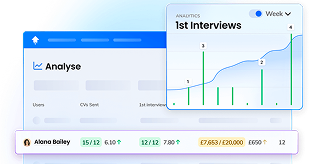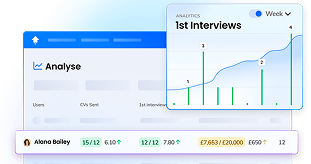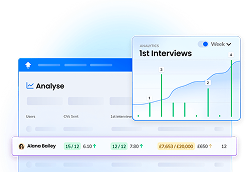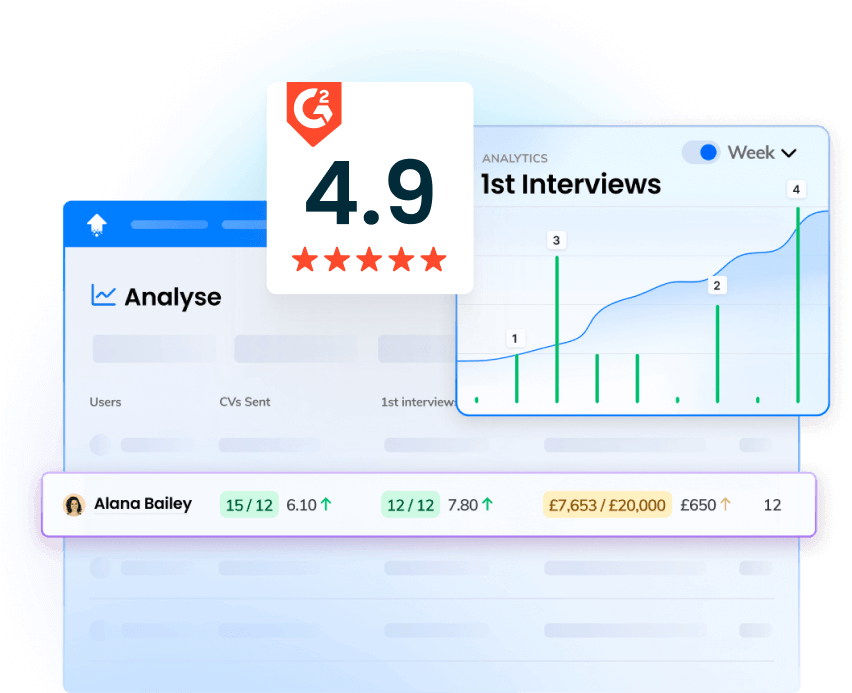In a challenging economic landscape, recruitment agencies must work harder than ever to attract and retain clients.
So it’s no surprise that many agencies are taking a performance-based recruitment approach.
Because when you consistently optimise your recruitment funnel, you’ll fill more placements and deliver a better experience for your clients — which ultimately means higher retention and more revenue for your agency.
Sounds good, right?
In this article, we’re going to discuss everything you need to know about performance-based hiring, including:
- How it works and what benefits it provides
- How to implement performance recruiting
- How recruitment agencies can foster a performance-driven culture
Let’s get into it…
The Essence of Performance-Based Recruiting
From the perspective of a recruitment agency, performance-based hiring is about giving your team the training, tools, and motivation to scour the top talent market and fill vacant positions faster, at a higher rate.
Globally, there’s been a significant uptick in search activity around phrases like “performance recruiting” over the past decade:

This reflects increased competition in the recruitment market and, subsequently, pressure on recruitment agencies to find efficiencies in their operations.
So what can you actually do to transform your agency into a lean, mean, talent-sourcing machine?
As with so much in the world of recruitment, it all comes down to the hiring funnel…
- Jobs added
- CVs sent
- Interviews booked
- Placements filled
- Revenue
…and how each stage can be optimised to drive performance.
For instance, data might show that your recruiters need to share an average of five CVs to book an interview, and that it takes seven interviews to secure a placement.
Armed with this knowledge, you can seek efficiencies — like using AI to screen applicants faster.
Taking things a step further, you can drill down to the individual recruiter level to identify everything required to reach optimal performance, from the coaching you provide and the targets you set to the compensation and incentives you offer.
Advantages of a Performance-Based Hiring Process
Let’s consider the specific benefits of performance recruitment for agencies:
Faster Fill Rates
Cutting down the time taken to find the right job candidates for the role and placing them successfully is the key focus of performance recruiting.
In the process, agencies that adopt a performance-based approach tend to identify a whole host of additional efficiencies and optimisations.
For instance, you might decide to overhaul your compensation and incentives with the specific goal of speeding up fill rates, but in the process you might also reduce turnover from your recruitment team — thereby saving you money on hiring and onboarding new team members.
And those savings can be invested in other efficiency-driving measures.
Increased Client Satisfaction and Retention
At the heart of things, recruitment agency clients have simple goals: they just want you to find the strongest talent, fast.
Of course, if it was that simple to achieve, everyone would be doing it.
But it means that any steps you take to fill vacancies more efficiently will ultimately help to improve client satisfaction.
And what happens when your clients are happy?
They stick with you for longer.
Higher Revenue
Ultimately, pretty much every decision you make should be influenced by one overriding objective: generating more revenue.
Because performance-based recruitment isn’t about increasing efficiencies for the sake of it — it’s about retaining more clients and winning more business.
All of which results in higher revenue for your agency.
Implementing Performance-Based Recruiting: A 6-Step Plan
Clearly, performance-based hiring practices are well worth adopting.
But how?
In this section, we’ll talk you through the end-to-end process of implementing a performance recruiting plan:
Step 1: Gathering Data
No doubt you’re eager to start ripping up existing recruiting processes and splashing money on the latest tools and training methods.
Pump the brakes, because you’re overlooking an essential step: understanding the data you need to gather to make informed optimisation decisions.
This will probably involve a combination of top-level metrics like…
- Revenue booked
- Average time to fill
- Jobs added
…alongside more granular, recruiter-level KPIs, such as:
- CVs sent
- First interviews booked
- Successful placement made
👉 Find out more: From Outreach to Onboarding: 17 Recruiting KPIs to Track
Step 2: Finding Efficiencies
In the process of gathering and analysing all that data, you likely have identified a handful of areas in which things aren’t running as smoothly as they could be.
Like, maybe you’ve seen a big uptick in the number of CVs your recruiters need to send to secure a first interview.
That speaks to problems with your CV vetting, job descriptions, or job board postings (or perhaps all three). Perhaps you need to do some training around the issue or invest in software to ensure only the best CVs from the most promising candidates end up in the hands of hiring managers.
Clearly, we can’t help you with the specifics — every recruitment agency has its own strengths and weaknesses!
But this is your time to identify the key efficiencies that will make up your performance-based recruiting strategy.
Step 3: Setting Objectives
At step #1, you identified the specific metrics that will help you understand and optimise your agency’s processes.
Now it’s time to put some numbers to them.
Specifically, you need to set clear, measurable objectives so you can determine the success of your performance-based recruiting strategy.
For instance, let’s say you’ve invested in recruitment performance software to boost motivation across your team of recruiters. How can you tell if it’s working?
Well, you might expect a more motivated team to secure more first interviews.
To measure whether or not that’s actually happening, you could set a goal like: increase first interview bookings per recruiter by 5% quarter-on-quarter.
👉 Find out more: 9 SMART Goals for Recruiters and How to Track Them
Step 4: Selecting Tools
You can only get so far on human effort alone.
At some point, you’re going to have to invest in your recruitment tech stack — and your choices can make or break your whole performance-based recruiting plan.
Naturally, your requirements will vary based on the specifics of your agency, from the size of your team to the industries you serve.
But we genuinely believe that most recruitment agencies would benefit from our recruiting analytics software.

With OneUp, you can:
- Build reports in minutes, allowing team leaders to concentrate on the stuff that really matters — like analysing data and making strategic decisions to drive performance.
- Automate recurring reports, share them with the people who need to know, and get performance updates so you know whether your team is on track.
- Set meaningful targets and build custom dashboards so individual recruiters always know how they’re performing.
- Motivate your recruiters by fostering healthy competition through competitions, challenges, and real-time leaderboards.
- Celebrate success as a team, right down to setting individual celebration anthems!
👉 Find out more: Top 15 Gamification Recruitment Tools to Use in 2024
Step 5: Rolling Out
Having identified the goals you’re tracking, the processes you’re implementing, and the coaching and training you need to deliver, it’s time to put it all into action.
Again, the specific steps at this stage will vary from one agency to another.
But whatever you do, ensure that you communicate all the changes to your team.
Because if they’re not fully onboard, your performance recruiting plans are doomed to failure.
Step 6: Crunching the Numbers
Hopefully, by this point, you’ve successfully implemented a bunch of efficiency-driving measures.
Naturally, you want to know if it’s working, so it’s time to dig into the objectives you set at step #3.
If you’re smashing your targets, fantastic — now do more of it. Or if you’re falling short, investigate why and adjust your strategy accordingly.
Of course, you can only do that if you have the right reporting and analytics platform in place.
Our tools let you:
- Drill down into analytics to understand what contributed to your performance.
- Save as many reports as you like, so your most valuable data is only ever a click away.
- View performance-against-target charts for any metric by day, week, month, quarter, or year.

👉 Take a tour of our Reporting and Analytics Software for Recruitment Teams
Cultivating a Performance-Driven Culture
Your agency’s culture is directly related to the performance of your business.
So it’s clearly in your best interests to instil a performance-driven culture.
Here are some tips and best practices to make it happen:
- Communicate shared values and goals. Your recruiters will inevitably work harder if they feel like they’re contributing to something they believe in, not just making money for the founder.
- Celebrate positive behaviours. When a top performer on your team does something that embodies your culture and values, make sure everyone knows about it. Not only will it make them feel good, but it’ll reinforce those behaviours.
- Empower your recruiters. Everyone wants to feel like they’re trusted to do a good job. Give your recruiters the tools and resources they need to deliver success, such as giving them access to real-time performance data. (Hint: OneUp can help here.)
- Encourage feedback and open communication. Your recruiters should feel like their ideas are valued, that you’re eager to hear them — and that you’re willing to implement them, where relevant.
Challenges and Solutions
No one said implementing a performance recruitment strategy was easy.
You’ll inevitably face problems along the way.
Let’s consider some of the most common challenges and how you can overcome them:
| Challenge | Solution |
|
Lack of past performance data to inform future strategy. |
Use third-party data and industry benchmarks — it’s not perfect, but it’s better than nothing! |
|
Lack of budget for recruitment agency software. |
Build a business case and present it to your leadership team: it’s not about spending £X per month on a new tool, it’s about saving time, money, or both. |
|
Lack of team-level buy-in. |
It’s all about explaining how performance-based recruiting benefits them: the more efficiently they fill roles, the more they’ll earn. |
Conclusion
As we’ve seen, performance-based recruitment has wide-ranging benefits.
The more time and resources you invest in optimising the recruitment process, the more efficiently you’ll be able to fill roles — which, in turn, leads to:
- Happier clients
- Improved client retention
- More revenue
What agency would say “no” to any of those?
And, as we’ve also seen, it’s impossible to implement an effective performance recruiting strategy if your reporting and analytics tools aren’t fit for purpose.
That’s where OneUp comes in, helping agencies like yours visualise real-time data and understand the context behind key metrics.




















